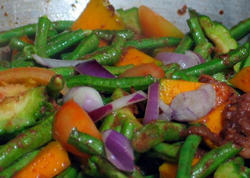Isabela Cousin: Unusual Food
Basic Food for Ilocanos
The Ilocos region, where several provinces share similar customs, language and food, has delicacies made up of rice and vegetables derived basically from the richness of their mountainous dry land. Most of their specialty are seasoned with fermented fish sauce. The region is famous for its Pinakbet- a mixture of several vegetables such as squash, okra, eggplant, ampalaya or bitter gourd and string beans cooked with bagoong or fermented fish paste. The way this dish is prepared varies in different regions. Some parts of Ilocos, which are closer to the sea, top a pinakbet based in soup with grilled fish, leaving the vegetables cooked until tender and seasoned with bagoong or fermented fish. Other’s cook this dish with sauteed pork in garlic, onion, tomatoes and shrimp paste along with assorted vegetables. Another authentic Ilocano dish is Dinengdeng. Malunggay or its fruit boiled in watery soup, seasoned with bagoong and topped with grilled fish. Ilocanos also are keen about grilled ampalaya with bagoong or fermented fish as the sauce dip. Ilocano delicacies sought to have been healthier than others but their regular use of fermented fish called bagoong, gets them closer to health impairment. Bagnet (dried pork belly) is an interesting dish, deep fried with bagoong until skin turns crispy. They also have made Longanisa famous all over the country as a main Filipino breakfast dish. It is a sweet fatty ground pork sausage basically fried and eaten with rice in the morning. Horrible as it may seem, aside from Cordillera region, Ilocos is another place where dog meat is a delicacy. Asucena is a dog meat dish cooked in thick tomato sauce, green peas and breadcrumbs. Locals from Benguet and mountain province say that eating this meat gives them extra strength and courage working in the steep mountains of Cordillera.
Simple and Basic Cooking: Pinakbet without Bagoong
The title of the entry sounds sacrilegious, I know. Pinakbet without bagoong. Well, tough. I am allergic to bagoong (shrimp paste) and even its fish version. In fact, there are certains brands of patis (fish sauce) that do not agree with me as well. Ironically, I love the Ilocano classic dish called pinakbet–not for the bagoong-flavored sauce but for the wonderful mixture of vegetables. And I always felt a little deprived when, growing up, everyone in the family could enjoy a hearty meal of pinakbet except me.
When I learned to cook, I would make pinakbet by substituting patis (the milder varieties) for bagoong. It satisfied the craving in a way but it lacked something. Then, two weeks ago, I bought a bottle of tuyo (salted dried herrings) soaked in olive oil intending to use it as one would use anchovies. I used a few pieces of tuyo with pasta (wonderful–will post the recipe within the week) and then wondered what I would do with the rest. Why not cook pinakbet? So, I did.
The cooked dish is less pungent though it has that distinct fishy aroma that characterizes the traditional pinakbet. The best part was that I could actually eat it without fear of getting a bum stomach afterwards.
If you’re one of those Filipinos living abroad who want to introduce your partner or your friends to the more exotic side of Filipino cuisine, you might want to break them in by using tuyo in olive oil in lieu of bagoong when introducing them to pinakbet.
Ingredients :
1/2 kilo of boiled pork belly or kasim (I think kasim is the shoulder), cut into 2-inch cubes
a bunch of sitaw (string beans), cut into 2-inch lengths
2 medium-sized eggplants, cut into 2-inch cubes or roughly the same size as the pork
6-8 pieces of okra, trimmed
1 whole garlic, peeled and finely minced
2 shallots, thinly sliced or diced
6 tomatoes, diced
3-4 pieces of tuyo in olive oil, flaked
3-4 tsps. of the oil in the bottle of tuyo
1 c. of fish broth
patis
Cooking procedure :
Note: To make fish broth, just boil the head and bones of a large fish in water. When I have the fish filleted in the market, I always bring home the head and the bones precisely for making fish broth. If fish broth is not available, you may substitute meat broth. Worst case scenario–use water.
Heat the oil in a thick-bottomed cooking pan (a wok or the traditional carajay is best for even cooking). Add the pork cubes and cook over high heat until lightly browned. For a more authentic pinakbet, you might want to use cubes of bagnet or lechon kawali. Add the garlic, shallots, tomatoes and the flaked tuyo. Cook for about a minute. Add the vegetables and pour in the fish broth. Season with patis. Simmer for 10 to 15 minutes or until the vegetables are tender and the mixture is almost dry.
Serve at once with hot rice and enjoy!
